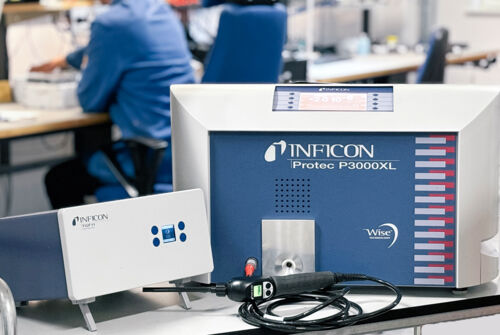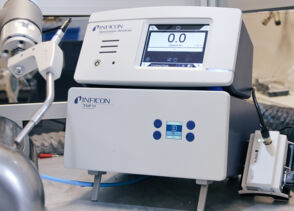Optimizing Leak Testing: Accurate Tracer Gas Filling and Evacuating
The Importance of Accurate Tracer Gas Handling

There are several methods of industrial leak testing, of which tracer gas leak detection is the most accurate. Tracer gases like helium or forming gas (5% hydrogen in nitrogen) offer high sensitivity, exact pinpointing and the ability to quantify the size of a leak.
Proper filling and evacuation of tracer gas is as important as the choice of the right leak testing method to reach accurate leak test results. Handling tracer gas the wrong way can lead to missed leaks in the worst case or, more commonly, false alarm problems due to high residual gas backgrounds.
The Importance of Correct Tracer Gas Handling in Leak Detection
When leak testing your products with a tracer gas, helium or diluted hydrogen, it is essential that you have tracer gas everywhere in your test part, at the right time and at the right pressure. For proper leak testing, it is also essential to evacuate the test part before filling it with tracer gas, as well as to re-fill it with ambient air at the end of the test.
Users within the HVACR industry are well-versed in the process of evacuating their products before filling them with refrigerants. Consequently, they sometimes handle the tracer gas filling themselves. In some cases, they engage with machine builders that integrate tracer gas handling in larger leak testing systems. Unfortunately, when designing such filling systems, a lack of knowledge about leak detection leads to unexpected problems, such as false alarms caused by high background levels and longer cycle times.
In other sectors, such as automotive and general industry, the knowledge of tracer gas filling is typically lower, also among subcontractors. This can lead to end-users having to develop their own solutions for filling and evacuating tracer gas from the test part, leading to unnecessary work and potential delays.
The Consequences of Inaccurate Tracer Gas Filling and Evacuation
When handling tracer gas for leak detection, the main challenges users might encounter are:
- Tracer gas dilution: If the test part is not evacuated before filling, the tracer gas gets diluted when mixed with air. Tracer gas dilution reduces the capability to find leaks.
- Creation of air pockets: If the test part is not evacuated before filling, the air inside it will be pushed to the end of the geometry, creating 'air pockets.' This is especially important for long and narrow geometries. Air pockets will prevent the tracer gas from reaching all areas. As a result, potential leaks will only release air and cannot be detected by the leak detector. Completely evacuating the system before filling it with tracer gas is essential to avoid air pockets.

- Background contamination: Background levels of the tracer gas in the work station can interfere with leak tests. This is especially problematic in environments with bad ventilation. Any tracer gas released in the work area may cause contamination of the test area, resulting in false alarms and longer cycle times. Controlled evacuation of the tracer gas after the leak test is crucial to avoid interferences.
- Manual tracer gas filling: Setting up home-made filling equipment is often time-consuming and does not satisfy the necessary leak test conditions. A proven solution will offer quick set-up and easy installation.
The solutions from INFICON
The tracer gas fillers from INFICON can be used as standalone units or as part of an automated or semi-automated leak detection system. The set-up, including filling recipes and gas connection, is usually completed in less than one hour. The fillers handle both helium and forming gas and, in combination with the INFICON leak detectors, provide a high performance system for demanding leak testing.
The Tracer Gas Filler ILS500 F is a filler with complete tooling and gas filling functions. It can perform a complete test sequence, from gas injection and evacuation to tooling connection and disconnection, gross leak test, vacuum decay test, pressure decay test, blockage test and recipe handling. Available also in high pressure version, ILS500 F eliminates the need for time-consuming manual tracer gas filling and significantly improves test quality assurance. The unit offers the advantage of a more automated process and handles tracer gas filling in a wider pressure range (0.05 – 30 bar).
The Tracer Gas Filler TGF11 is a stand-alone instrument which allows for easy and reliable tracer gas filling and evacuating. It ensures that the entire test object is filled with tracer gas at the right time and at the right pressure. It also evacuates the tracer gas after the test avoiding contamination of the work area. The user interface allows easy, intuitive control of the instrument reducing operating errors. This filler requires minimum maintenance and is well-suited for use in industrial serial production. The TGF11 is a simple, fast and cost-efficient solution to fill and evacuate tracer gas in objects in a wide pressure range (0.05 – 10 bar).


Want to Learn More about Correct Tracer Gas Filling and Evacuating?
Download our Application Note or watch our On-Demand Webinar "Not finding all relevant leaks? The essentials of tracer gas handling"!
Want to Stay Updated on Leak Detection?
Our newsletter offers regular updates on our latest products, applications, upcoming events, and other interesting news.